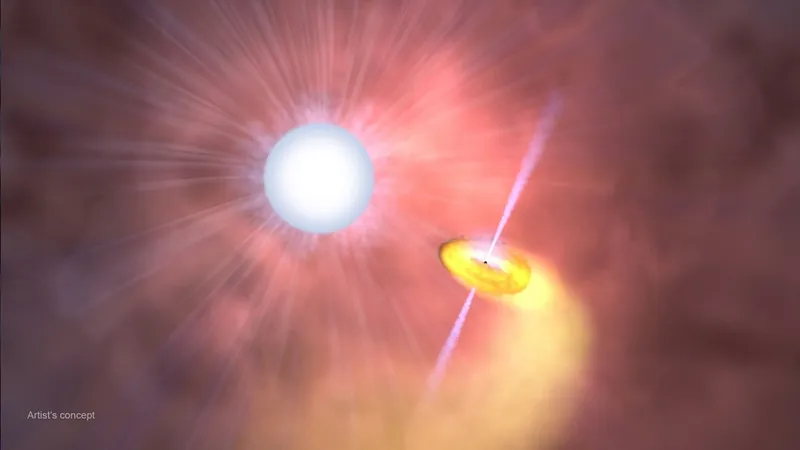
XRISM Mission Unveils Secrets of the Mysterious Cygnus X-3 Stellar System!
2024-11-25
Author: Michael
Introduction
In a groundbreaking achievement, the Japan-led XRISM (X-ray Imaging and Spectroscopy Mission) observatory has unveiled an unprecedented portrait of the gas dynamics within Cygnus X-3, a star system shrouded in mystery and renowned in X-ray astronomy.
Overview of Cygnus X-3
Located approximately 32,000 light-years away in the northern constellation Cygnus, Cygnus X-3 consists of a rare high-mass star known as a Wolf-Rayet star and its compact companion, which is believed to be a black hole. The dynamics of this binary system are indeed fascinating, as they orbit each other in a mere 4.8 hours, accentuating the extreme gravitational interactions happening at play.
Research Insights
Ralf Ballhausen, a postdoctoral associate from the University of Maryland—working with NASA’s Goddard Space Flight Center—highlighted the intriguing nature of the massive star. “The strong stellar winds produced by the Wolf-Rayet star aggressively strip gas from its surface, leading to unique interactions with its compact partner that ultimately produces X-ray emissions,” he explained.
Study Publication and Importance
The recent study, led by Ballhausen, will be featured in an upcoming edition of *The Astrophysical Journal* and has already attracted attention on arXiv. Co-author Timothy Kallman from NASA Goddard noted, “Cygnus X-3 is a Goldilocks target for XRISM—its brightness is just right for detailed observation, making it a rite of passage for any new X-ray mission.”
XRISM Mission Overview
XRISM, pronounced "crism," is a collaborative effort between JAXA (Japan Aerospace Exploration Agency), NASA, and ESA (European Space Agency). One of the mission's standout instruments is the Resolve microcalorimeter spectrometer, which captured detailed spectra during an 18-hour observation of Cygnus X-3 in late March.
Gas Dynamics Observations
Astonishingly, the data reveals an intricate dance of gas flow and interactions stemming from the star’s stellar winds and the gravitational pull of its black hole companion. The unique conditions present in this region lead to complex behaviors, including a turbulent wake created by the compact object traversing the high-velocity gas.
Previous Observations
Despite the challenges posed by thick dust clouds obscuring visible light from Cygnus X-3, researchers have previously studied the system using radio, infrared, and gamma-ray observations. XRISM's ability to focus on X-ray emissions has revealed how gas in the system becomes ionized and illuminated, producing a spectrum littered with peaks and valleys that tell the story of gas inflow and outflow.
Unexpected Spectral Features
However, the study was made even more compelling by unexpected spectral features. For instance, the Doppler effect plays a significant role here, causing gas flowing towards us to exhibit shifted energies. Some of the gas travels at astonishing speeds—up to 930,000 mph (1.5 million kph)—leading to distinctive absorption and emission signatures that required careful interpretation.
Future Prospects
With XRISM's detailed spectrum, particularly rich in features from ionized iron, scientists are hopeful they can glean more insights into these dynamics. “There’s still much to explore in this spectrum, and we ultimately aim to confirm whether the compact object is indeed a black hole,” said Brian Williams, NASA’s project scientist for XRISM.
Conclusion
As XRISM continues its mission, it promises to deepen our understanding of such stellar systems, paving the way for more discoveries hidden in the vast universe. Will this mission reveal more cosmic secrets? Stay tuned!









 Brasil (PT)
Brasil (PT)
 Canada (EN)
Canada (EN)
 Chile (ES)
Chile (ES)
 España (ES)
España (ES)
 France (FR)
France (FR)
 Hong Kong (EN)
Hong Kong (EN)
 Italia (IT)
Italia (IT)
 日本 (JA)
日本 (JA)
 Magyarország (HU)
Magyarország (HU)
 Norge (NO)
Norge (NO)
 Polska (PL)
Polska (PL)
 Schweiz (DE)
Schweiz (DE)
 Singapore (EN)
Singapore (EN)
 Sverige (SV)
Sverige (SV)
 Suomi (FI)
Suomi (FI)
 Türkiye (TR)
Türkiye (TR)